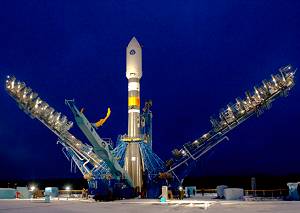At the same time, the 30th crew of the space station that was launched in a similar rocket days before arrived at the station * The third stage engine that was supposed to put the satellite into polar orbit did not work and the launcher with the satellite on it fell near Novoribirsk, more than 2,200 kilometers from the launch facility in northern Siberia

The launcher carrying a military communications satellite crashed following a series of launch failures in the past year, fortunately - not in manned launches * The Soyuz spacecraft carrying the 30 crew members arrived at the space station
The Soyuz rocket fell to the ground a few minutes after its launch on Friday. The Russian media reports that the remains were found in the Novosibirsk region, the third largest city in Russia. Novosibirsk is about 2,200 kilometers from Kosmo South Plastsk. The missile carried a Meridian-type communications satellite for the Russian military. A third stage of the Fregat type was supposed to accelerate the Meridian payload into an elliptical orbit stretching up to an altitude of about 40 thousand kilometers.
This orbit, known as the Molinia orbit, allows the satellite to remain under observation of Russian territory for a few hours during the entire orbit. Satellites of this type cover the polar regions, which are outside the range of communication satellites located in equatorial orbits. The Meridian type communication satellites are used as relays for ground military units, ground stations, aircraft and ships with the command and control centers. The satellite launched on Friday was the fifth launched by Russia since 2006.
For the third time since December 2010, the launch of a Russian Soyuz rocket failed, until now these were research navigation and communication satellites. Another Soyuz rocket crashed in August carrying the Progress supply spacecraft that was destined for the International Space Station. In addition, the Phobos Grunt spacecraft is stuck in orbit around Earth after its rocket engines failed to fire shortly after launch in November. It is estimated that the spacecraft will fall on the zinc sphere around January 13.
Friday's mishap occurred about seven minutes after the Soyuz rocket lifted off from Kosmo South Plastsk in northern Russia at 12:08 GMT. The gasoline-powered missile was headed south from Plastsk, a military launch facility in Siberia's Arkhangelsk Oblast.
The problem occurred during the ignition of the third stage, but there is still no reliable information about the causes of the malfunction. "This is a significant malfunction," says Vladimir Popovkin, head of Roscosmos, the Russian space agency. "This proves that this area of the Hal industry is in crisis."
The Soyuz rocket is now the only launcher capable of bringing crew members to the International Space Station, but the mission that crashed was, as mentioned, a different and unmanned version of the launcher.
The previous failures are still being investigated, including those that caused the loss of six Global Star communications satellites on December 28, 2010. Soyuz rockets are scheduled to carry another cargo spacecraft to the space station in January and another crew of three astronauts in late March.
The 30th team arrived safely at the station
At the same time, the three members of the 30th crew in their Soyuz TMA-03M spacecraft arrived safely at the space station on Friday afternoon. Oleg Kononenko from Russia, Don Pettit from NASA and Andre Kuypers from the European Space Agency docked in the Rasvet module in the Russian section of the station, and a few hours later they met with the other three crew members - station commander Dan Burbank and cosmonauts Anton Shkapelrov and Antony Ivanishin, who are also staying a little longer on the station renewed.
The two set off on Wednesday, two days before the failed launch, from the Baikonur Space Center in Kazakhstan.

One response
I am happy for every Russian failure